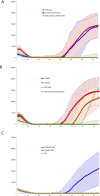α-Synuclein RT-QuIC assay in cerebrospinal fluid of patients with dementia with Lewy bodies
- PMID: 31599499
- PMCID: PMC6801172
- DOI: 10.1002/acn3.50897
α-Synuclein RT-QuIC assay in cerebrospinal fluid of patients with dementia with Lewy bodies
Abstract
We applied RT-QuIC assay to detect α-synuclein aggregates in cerebrospinal fluid (CSF) of patients with suspected Creutzfeldt-Jakob disease who had a neuropathological diagnosis of dementia with Lewy bodies (DLB) (n = 7), other neurodegenerative diseases with α-synuclein mixed pathology (n = 20), or without Lewy-related pathology (n = 49). The test had a sensitivity of 92.9% and specificity of 95.9% in distinguishing α-synucleinopathies from non-α-synucleinopathies. When performed in the CSF of patients with DLB (n = 36), RT-QuIC was positive in 17/20 with probable DLB, 0/6 with possible DLB, and 0/10 with Alzheimer disease. These results indicate that RT-QuIC for α-synuclein is an accurate test for DLB diagnosis.
© 2019 University of Verona. Annals of Clinical and Translational Neurology published by Wiley Periodicals, Inc. on behalf of American Neurological Association.
Conflict of interest statement
All authors declare no conflict of interests.
Figures

References
-
- Rizzo G, Arcuti S, Copetti M, et al. Accuracy of clinical diagnosis of dementia with Lewy bodies: a systematic review and meta‐analysis. J Neurol Neurosurg Psychiatry 2018;89:358–366. - PubMed
-
- Berg D, Adler CH, Bloem BR, et al. Movement disorder society criteria for clinically established early Parkinson's disease. Mov Disord. 2018;33:1643–1646. - PubMed
Publication types
MeSH terms
Substances
Grants and funding
LinkOut - more resources
Full Text Sources
Medical

